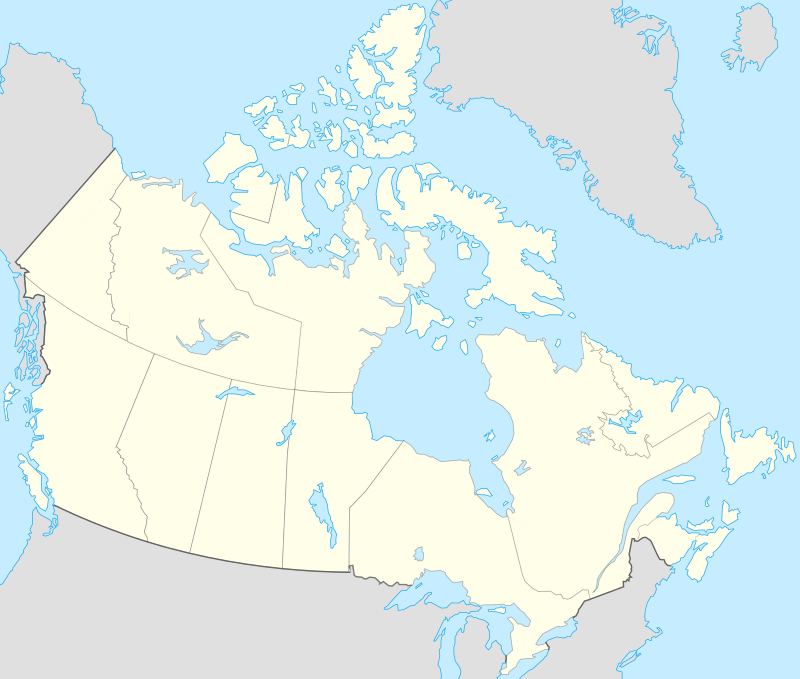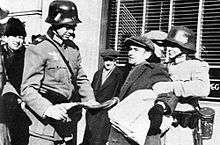Winnipeg
Winnipeg (/ˈwɪnɪpɛɡ/ (![]()
Winnipeg | |
|---|---|
| City of Winnipeg Ville de Winnipeg (French) | |
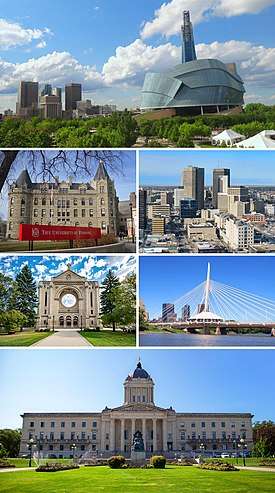 From top, left to right: Winnipeg panorama featuring the Canadian Museum for Human Rights, Wesley Hall at the University of Winnipeg, Downtown Winnipeg, Saint Boniface Cathedral, Esplanade Riel bridge and the Manitoba Legislative Building | |
| Nickname(s): "Winterpeg" | |
| Motto(s): | |
| Coordinates: 49°53′4″N 97°8′47″W | |
| Country | Canada |
| Province | Manitoba |
| Region | Winnipeg Metro Region |
| Established | 1738 (Fort Rouge) |
| Renamed | 1822 (Fort Garry) |
| Incorporated | 1873 (City of Winnipeg) |
| Government | |
| • Mayor | Brian Bowman |
| • Governing body | Winnipeg City Council |
| • MPs | List of MPs
|
| • MLAs | List of MLAs
|
| Area | |
| • Land | 464.09 km2 (179.19 sq mi) |
| • Metro | 5,306.79 km2 (2,048.96 sq mi) |
| Elevation | 239 m (784 ft) |
| Population | |
| • Provincial capital city | 705,244 (7th) |
| • Density | 1,430/km2 (3,700/sq mi) |
| • Urban | 705,244 (7th) |
| • Urban density | 1,429/km2 (3,700/sq mi) |
| • Metro | 778,489 (8th) |
| • Metro density | 146.70/km2 (380.0/sq mi) |
| Demonym(s) | Winnipegger |
| Time zone | UTC−6 (CST) |
| • Summer (DST) | UTC−5 (CDT[9]) |
| Area code(s) | 204 and 431 |
| Website | www |
The city is named after the nearby Lake Winnipeg; the name comes from the Western Cree words for muddy water. The region was a trading centre for Indigenous peoples long before the arrival of Europeans. French traders built the first fort on the site in 1738. A settlement was later founded by the Selkirk settlers of the Red River Colony in 1812, the nucleus of which was incorporated as the City of Winnipeg in 1873. As of 2016, Winnipeg is the seventh-most populated municipality in Canada, with a resident population of about 778,500.[5] Being far inland, the local climate is extremely seasonal even by Canadian standards with average January lows of around −21 °C (−6 °F) and average July highs of 26 °C (79 °F).[4]
Known as the "Gateway to the West", Winnipeg is a railway and transportation hub with a diversified economy. This multicultural city hosts numerous annual festivals, including the Festival du Voyageur, the Winnipeg Folk Festival, the Jazz Winnipeg Festival, the Winnipeg Fringe Theatre Festival, and Folklorama. Winnipeg was the first Canadian host of the Pan American Games. It is home to several professional sports franchises, including the Winnipeg Blue Bombers (Canadian football), the Winnipeg Jets (ice hockey), Manitoba Moose (ice hockey), Valour FC (soccer), and the Winnipeg Goldeyes (baseball).
History
Early history
Winnipeg lies at the confluence of the Assiniboine and the Red River of the North, a location now known as "The Forks". This point was at the crossroads of canoe routes travelled by First Nations before European contact.[10] Winnipeg is named after nearby Lake Winnipeg; the name is a transcription of the Western Cree words for muddy or brackish water.[11][12] Evidence provided by archaeology, petroglyphs, rock art and oral history indicates that native peoples used the area in prehistoric times for camping, harvesting, hunting, tool making, fishing, trading and, farther north, for agriculture.[13]
Estimates of the date of first settlement in this area range from 11,500 years ago for a site southwest of the present city to 6,000 years ago at The Forks.[12][14] In 1805, Canadian colonists observed First Nations peoples engaged in farming activity along the Red River. The practice quickly expanded, driven by the demand by traders for provisions.[15] The rivers provided an extensive transportation network linking northern First Peoples with those to the south along the Missouri and Mississippi rivers. The Ojibwe made some of the first maps on birch bark, which helped fur traders navigate the waterways of the area.[16]
Sieur de La Vérendrye built the first fur trading post on the site in 1738, called Fort Rouge.[17][18] French trading continued at this site for several decades before the arrival of the British Hudson's Bay Company after France ceded the territory following its defeat in the Seven Years' War.[19] Many French men who were trappers married First Nations women; their mixed-race children hunted, traded, and lived in the area. They gradually developed as an ethnicity known as the Métis because of sharing a traditional culture.[20]
.png)
Lord Selkirk was involved with the first permanent settlement (known as the Red River Colony), the purchase of land from the Hudson's Bay Company, and a survey of river lots in the early 19th century.[21] The North West Company built Fort Gibraltar in 1809, and the Hudson's Bay Company built Fort Douglas in 1812, both in the area of present-day Winnipeg.[22] The two companies competed fiercely over trade.[23] The Métis and Lord Selkirk's settlers fought at the Battle of Seven Oaks in 1816. In 1821, the Hudson's Bay and North West Companies merged, ending their long rivalry.[24] Fort Gibraltar was renamed Fort Garry in 1822 and became the leading post in the region for the Hudson's Bay Company.[25] A flood destroyed the fort in 1826 and it was not rebuilt until 1835.[25] A rebuilt section of the fort, consisting of the front gate and a section of the wall, is near the modern-day corner of Main Street and Broadway in downtown Winnipeg.[26]
In 1869–70, present-day Winnipeg was the site of the Red River Rebellion, a conflict between the local provisional government of Métis, led by Louis Riel, and newcomers from eastern Canada. General Garnet Wolseley was sent to put down the uprising. The Manitoba Act of 1870 made Manitoba the fifth province of the three-year-old Canadian Confederation.[27][28][29] Treaty 1, which encompassed the city and much of the surrounding area, was signed on 3 August 1871 by representatives of the Crown and local Indigenous groups, comprising the Brokenhead Ojibway, Sagkeeng, Long Plain, Peguis, Roseau River Anishinabe, Sandy Bay and Swan Lake communities.[30] On 8 November 1873, Winnipeg was incorporated as a city, with the Selkirk settlement as its nucleus.[31] Métis legislator and interpreter James McKay named the city.[32] Winnipeg's mandate was to govern and provide municipal services to citizens attracted to trade expansion between Upper Fort Garry / Lower Fort Garry and Saint Paul, Minnesota.[33]
Winnipeg developed rapidly after the coming of the Canadian Pacific Railway in 1881.[34] The railway divided the North End, which housed mainly Eastern Europeans, from the richer Anglo-Saxon southern part of the city.[12] It also contributed to a demographic shift beginning shortly after Confederation that saw the francophone population decrease from a majority to a small minority group. This shift resulted in Premier Thomas Greenway controversially ending legislative bilingualism and removing funding for French Catholic Schools in 1890.[35]
Modern history (1900–present)
By 1911, Winnipeg was Canada's third-largest city.[12] However, the city faced financial difficulty when the Panama Canal opened in 1914.[36] The canal reduced reliance on Canada's rail system for international trade; the increase in shipping traffic helped Vancouver to surpass Winnipeg in both prosperity and population by the end of World War I.[37]
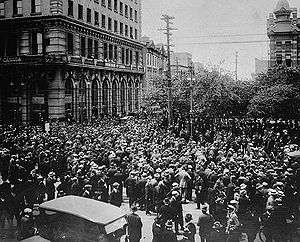
More than 30,000 workers walked off their jobs in May 1919 in what came to be known as the Winnipeg general strike.[38] The strike was a product of postwar recession, labour conditions, the activity of union organizers and a large influx of returning World War I soldiers seeking work.[39] After many arrests, deportations, and incidents of violence, the strike ended on 21 June 1919 when the Riot Act was read and a group of Royal Canadian Mounted Police officers charged a group of strikers.[40] Two strikers were killed and at least thirty others were injured on the day that became known as Bloody Saturday; the event polarized the population.[40] One of the leaders of the strike, J. S. Woodsworth, went on to found Canada's first major socialist party, the Co-operative Commonwealth Federation, which later became the New Democratic Party.[41]
The Manitoba Legislative Building, constructed mainly of Tyndall stone, opened in 1920; its dome supports a bronze statue finished in gold leaf, titled "Eternal Youth and the Spirit of Enterprise" (commonly known as the "Golden Boy").[42] The stock market crash of 1929 and the Great Depression resulted in widespread unemployment, worsened by drought and low agricultural prices.[43] The Depression ended after the start of World War II in 1939.[12]
In the Battle of Hong Kong, The Winnipeg Grenadiers were among the first Canadians to engage in combat against Japan. Battalion members who survived combat were taken prisoner and endured brutal treatment in prisoner of war camps.[44] In 1942, the Victory Loan Campaign staged a mock Nazi invasion of Winnipeg to promote awareness of the stakes of the war in Europe.[45][46] When the war ended, pent-up demand generated a boom in housing development, although building activity was checked by the 1950 Red River flood.[47] The federal government estimated damage at over $26 million, although the province indicated that it was at least double that.[48]
Before 1972, Winnipeg was the largest of thirteen cities and towns in a metropolitan area around the Red and Assiniboine Rivers. In 1960 the Metropolitan Corporation of Greater Winnipeg was established to co-ordinate service delivery in the metropolitan region.[33] A consolidated metropolitan "unicity" government incorporating Winnipeg and its surrounding municipalities was established on 27 July 1971, taking effect in 1972.[49] The City of Winnipeg Act incorporated the current city.[12] In 2003 the City of Winnipeg Act was repealed and replaced with the City of Winnipeg Charter.[33]
Winnipeg experienced a severe economic downturn in advance of the early 1980s recession, during which the city incurred closures of prominent businesses, including the Winnipeg Tribune, as well as the Swift's and Canada Packers meat packing plants.[50] In 1981, Winnipeg was one of the first cities in Canada to sign a tripartite agreement with the provincial and federal governments to redevelop its downtown area,[51] and the three levels of government contributed over $271 million to its development.[52] In 1989, the reclamation and redevelopment of the CNR rail yards turned The Forks into Winnipeg's most popular tourist attraction.[10][12] The city was threatened by the 1997 Red River flood as well as further floods in 2009 and 2011,[53] in each of these floods, the Red River Floodway was used to safely protect the city.
Geography
Winnipeg lies at the bottom of the Red River Valley, a flood plain with an extremely flat topography.[54] It is on the eastern edge of the Canadian Prairies in Western Canada and is known as the "Gateway to the West".[12] Winnipeg is bordered by tallgrass prairie to the west and south and the aspen parkland to the northeast, although most of the native prairie grasses have been removed for agriculture and urbanization.[55] It is relatively close to many large Canadian Shield lakes and parks, as well as Lake Winnipeg (the Earth's 11th largest freshwater lake).[56] Winnipeg has North America's largest extant mature urban elm forest.[57] The city has an area of 464.08 km2 (179.18 sq mi).[2]
Winnipeg has four major rivers: the Red, Assiniboine, La Salle and Seine.[58] The city was subject to severe flooding in the past. The Red River reached its greatest flood height in 1826. Another large flood in 1950 caused millions of dollars in damage and mass evacuations.[59] This flood prompted Duff Roblin's provincial government to build the Red River Floodway to protect the city; the project began in 1962 and was completed in 1968.[12] In the 1997 flood, flood control dikes were reinforced and raised using sandbags; Winnipeg suffered limited damage compared to the flood's impact on cities without such structures, such as Grand Forks, North Dakota.[60] The generally flat terrain and the poor drainage of the Red River Valley's clay-based soil also results in many mosquitoes during wetter years.[61]
Climate
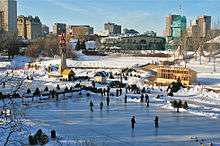
Winnipeg's location in the Canadian Prairies gives it a warm-summer humid continental climate[62] (Köppen Dfb),[63] with warm, humid summers, and long, extremely cold winters. Summers have a July mean average of 19.7 °C (67.5 °F).[64] Winters are the coldest and driest time of year, with the January mean average around −16.4 °C (2.5 °F) and total winter precipitation averaging 55 mm (2.2 in).[65] Temperatures occasionally drop below −40.0 °C (−40 °F).[66] The actual air temperature drops below −30 °C (−22 °F) on average 12.6 days annually[4] and rises above 30 °C (86 °F) 13.3 days of the year.[67] On average there are 317.8 days per year with measurable sunshine, with July seeing the most on average.[68] With 2353 hours of sunshine per year, Winnipeg is the second sunniest city in Canada.[69] Total annual precipitation (both rain and snow) is just over 51 centimetres (20 in).[70] Thunderstorms are very common during summer, and sometimes severe enough to produce tornadoes.[71] Low wind chill values are a common occurrence in the local climate. The wind chill has gone down as low as −57 °C (−70.6 °F) and on average there are twelve days of the year that can reach a wind chill below −40 °C (−40 °F).[4]
The highest temperature ever recorded in Winnipeg was 42.2 °C (108 °F) on 11 July 1936 while the highest daily low temperature was 28.3 °C (82.9 °F) on 12 July 1936.[72] The apparent heat can be even more extreme due to bursts of humidity, and on 25 July 2007 a humidex reading of 47.3 °C (117.1 °F) was measured.[4]
The frost-free season is comparatively long for a location with such severe winters. The last spring frost is on average around 23 May, whilst the first fall frost is on 22 September.[4]
| Climate data for Winnipeg James Armstrong Richardson International Airport, elevation: 239 m (784 ft), 1981–2010 normals, extremes 1872–present[lower-alpha 1] | |||||||||||||
|---|---|---|---|---|---|---|---|---|---|---|---|---|---|
| Month | Jan | Feb | Mar | Apr | May | Jun | Jul | Aug | Sep | Oct | Nov | Dec | Year |
| Record high humidex | 6.3 | 11.1 | 28.0 | 34.1 | 40.2 | 46.1 | 47.3 | 45.5 | 45.9 | 34.3 | 23.9 | 9.3 | 47.3 |
| Record high °C (°F) | 7.8 (46.0) |
11.7 (53.1) |
23.7 (74.7) |
34.3 (93.7) |
37.8 (100.0) |
38.3 (100.9) |
42.2 (108.0) |
40.6 (105.1) |
38.8 (101.8) |
31.1 (88.0) |
23.9 (75.0) |
11.7 (53.1) |
42.2 (108.0) |
| Average high °C (°F) | −11.3 (11.7) |
−8.1 (17.4) |
−0.8 (30.6) |
10.9 (51.6) |
18.6 (65.5) |
23.2 (73.8) |
25.9 (78.6) |
25.4 (77.7) |
19.0 (66.2) |
10.5 (50.9) |
−0.5 (31.1) |
−8.5 (16.7) |
8.7 (47.7) |
| Daily mean °C (°F) | −16.4 (2.5) |
−13.2 (8.2) |
−5.8 (21.6) |
4.4 (39.9) |
11.6 (52.9) |
17.0 (62.6) |
19.7 (67.5) |
18.8 (65.8) |
12.7 (54.9) |
5.0 (41.0) |
−4.9 (23.2) |
−13.2 (8.2) |
3.0 (37.4) |
| Average low °C (°F) | −21.4 (−6.5) |
−18.3 (−0.9) |
−10.7 (12.7) |
−2.0 (28.4) |
4.5 (40.1) |
10.7 (51.3) |
13.5 (56.3) |
12.1 (53.8) |
6.4 (43.5) |
−0.5 (31.1) |
−9.2 (15.4) |
−17.8 (0.0) |
−2.7 (27.1) |
| Record low °C (°F) | −44.4 (−47.9) |
−45.0 (−49.0) |
−38.9 (−38.0) |
−27.8 (−18.0) |
−11.7 (10.9) |
−6.1 (21.0) |
1.1 (34.0) |
−1.1 (30.0) |
−8.3 (17.1) |
−20.6 (−5.1) |
−36.7 (−34.1) |
−47.8 (−54.0) |
−47.8 (−54.0) |
| Record low wind chill | −56.4 | −57.1 | −49.6 | −35.8 | −20.8 | −7.9 | 0.0 | 0.0 | −11.5 | −24.2 | −48.1 | −50.6 | −57.1 |
| Average precipitation mm (inches) | 19.9 (0.78) |
13.8 (0.54) |
24.5 (0.96) |
30.0 (1.18) |
56.7 (2.23) |
90.0 (3.54) |
79.5 (3.13) |
77.0 (3.03) |
45.8 (1.80) |
37.5 (1.48) |
25.0 (0.98) |
21.5 (0.85) |
521.1 (20.52) |
| Average rainfall mm (inches) | 0.2 (0.01) |
2.7 (0.11) |
9.7 (0.38) |
19.2 (0.76) |
54.1 (2.13) |
90.0 (3.54) |
79.5 (3.13) |
77.0 (3.03) |
45.5 (1.79) |
32.7 (1.29) |
6.9 (0.27) |
1.5 (0.06) |
418.9 (16.49) |
| Average snowfall cm (inches) | 23.7 (9.3) |
12.5 (4.9) |
16.5 (6.5) |
10.6 (4.2) |
2.6 (1.0) |
0.0 (0.0) |
0.0 (0.0) |
0.0 (0.0) |
0.3 (0.1) |
4.8 (1.9) |
19.9 (7.8) |
23.0 (9.1) |
113.7 (44.8) |
| Average precipitation days (≥ 0.2 mm) | 12.2 | 8.0 | 9.2 | 7.2 | 11.5 | 13.3 | 11.4 | 10.7 | 10.4 | 9.4 | 10.3 | 11.8 | 125.3 |
| Average rainy days (≥ 0.2 mm) | 0.67 | 0.93 | 2.9 | 5.1 | 11.3 | 13.3 | 11.4 | 10.7 | 10.3 | 7.9 | 3.0 | 0.84 | 78.3 |
| Average snowy days (≥ 0.2 cm) | 12.4 | 7.7 | 7.4 | 2.9 | 0.56 | 0.0 | 0.0 | 0.0 | 0.11 | 2.3 | 8.6 | 11.5 | 53.5 |
| Average relative humidity (%) | 72.7 | 71.7 | 68.5 | 49.1 | 46.7 | 54.5 | 55.6 | 52.4 | 54.8 | 60.1 | 72.0 | 75.1 | 61.1 |
| Mean monthly sunshine hours | 114.7 | 133.9 | 181.9 | 241.4 | 285.2 | 276.3 | 308.3 | 281.4 | 189.0 | 147.4 | 93.9 | 99.5 | 2,352.9 |
| Mean daily sunshine hours | 3.7 | 4.8 | 5.9 | 8.0 | 9.2 | 9.2 | 9.9 | 9.1 | 6.3 | 4.8 | 3.1 | 3.2 | 6.4 |
| Percent possible sunshine | 42.9 | 47.2 | 49.5 | 58.6 | 59.8 | 56.6 | 62.6 | 62.8 | 49.8 | 44.1 | 34.4 | 39.2 | 50.6 |
| Average ultraviolet index | 1 | 1 | 2 | 4 | 6 | 7 | 7 | 6 | 4 | 2 | 1 | 1 | 4 |
| Source: Environment Canada[73][74][75] and Weather Atlas (daily sunshine hours and UV index)[76] | |||||||||||||
Cityscape
.jpg)
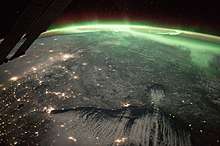
There are officially 236 neighbourhoods in Winnipeg.[77] Downtown Winnipeg, the city's financial heart and economic core, is centred on the intersection of Portage Avenue and Main Street. It covers about 1 square mile (2.6 km2) and is the city's fastest growing high-income neighbourhood.[78] More than 72,000 people work downtown, and over 40,000 students attend classes at its universities and colleges.[78] The past few decades have seen the downtown undergo major revitalization efforts; since 1999, over C$1.2 billion has been invested.[78]
Downtown Winnipeg's Exchange District is named after the area's original grain exchange, which operated from 1880 to 1913.[78] The 30-block district received National Historic Site of Canada status in 1997; it includes North America's most extensive collection of early 20th-century terracotta and cut stone architecture, 62 of downtown Winnipeg's 86 heritage structures,[78] Stephen Juba Park, and Old Market Square.[78] Other major downtown areas are The Forks, Central Park, Broadway-Assiniboine and Chinatown. Many of Downtown Winnipeg's major buildings are linked with the Winnipeg Walkway.[79]
Residential neighbourhoods surround the downtown in all directions; expansion is greatest to the south and west, although several areas remain underdeveloped.[80] The city's largest park, Assiniboine Park, houses the Assiniboine Park Zoo and the Leo Mol Sculpture Garden.[81] Other large city parks include Kildonan Park and St. Vital Park. The city's major commercial areas are Polo Park, Kildonan Crossing, South St. Vital, Garden City (West Kildonan), Pembina Strip, Kenaston Smart Centre, Osborne Village, and the Corydon strip.[82] The main cultural and nightlife areas are the Exchange District, The Forks, Osborne Village and Corydon Village (both in Fort Rouge), Sargent and Ellice Avenues (West End) and Old St. Boniface.[83] Osborne Village is Winnipeg's most densely populated neighbourhood[84] and one of the most densely populated neighbourhoods in Western Canada.[85]
Demographics
|
|
| |||||||||||||||||||||||||||||||||||||||||||||||||||||||||
| The drastic population increase between 1971 and 1981 was due in part to Winnipeg's amalgamation in 1972. Source: [86][87][88][89][90][91][92][93] | |||||||||||||||||||||||||||||||||||||||||||||||||||||||||||
As of the Canada 2016 Census there were 705,244 people living in Winnipeg proper,[94] with approximately 778,489 living in the Winnipeg Census Metropolitan Area (CMA).[95] Thus, Winnipeg is Manitoba's largest city and Canada's seventh largest city. Furthermore, the city represents 54.9% of the population of the province of Manitoba, the highest population concentration in one city of any province in Canada.[96][97] Apart from the city of Winnipeg, the Winnipeg CMA includes the rural municipalities of Springfield, St. Clements, Taché, East St. Paul, Macdonald, Ritchot, West St. Paul, Headingley, the Brokenhead 4 reserve, Rosser and St. François Xavier.[98] Statistics Canada's estimate of the Winnipeg CMA population as of 1 July 2017 is 825,713, making it the 7th largest CMA in Canada.[99]
| Ethnic origins, 2011[100] | ||
|---|---|---|
| Population | % | |
| English | 137,075 | 21.1 |
| Scottish | 113,465 | 17.4 |
| Canadian | 108,955 | 16.76 |
| German | 105,910 | 16.2 |
| Ukrainian | 98,860 | 15.2 |
| Irish | 85,800 | 13.2 |
| French | 85,025 | 13.1 |
| Aboriginal (incl. Métis) | 76,055 | 11.7 |
| Filipino | 58,255 | 9.0 |
| Polish | 50,385 | 7.8 |
As of the 2006 census, 48.3 percent of residents were male and 51.7 percent were female. 24.3 percent were 19 years old or younger, 27.4 percent were between 20 and 30 years old, and 34.0 percent were between 40 and 64 years old. The average age of a Winnipegger in May 2006 was 38.7, compared to an average of 39.5 for Canada as a whole.[101] Between the censuses of 2006 and 2011, Winnipeg's population increased by 4.8 percent, compared to 5.2 percent for Manitoba as a whole. The population density of the city of Winnipeg averaged 1,430 people per km2, compared with 2.2 for Manitoba.[102]
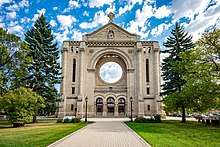
Winnipeg has a significant and increasing Aboriginal population, with both the highest percentage of Aboriginal peoples (12.5%) for any major Canadian city, and the highest total number of Aboriginals (86,035) for any single non-reserve municipality.[103] The Aboriginal population grew by 22% between 2001 and 2006, compared to an increase of 3% for the city as a whole; this population tends to be younger and less wealthy than non-Aboriginal residents.[104] Winnipeg also has the highest Métis population in both percentage (6.3%) and numbers (41,005); the growth rate for this population between 2001 and 2006 was 30%.[100][104]
The city has the greatest percentage of Filipino residents (8.7%) of any major Canadian city, although Toronto has more Filipinos by total population. In 2006, Winnipeg ranked seventh of the Canadian cities for percentage of residents of a visible minority.[100][105] As of the 2016 Census, the population was 63.9% European in origin (73.5% of the city was white in 2006), while non-aboriginal visible minorities represent 23.5% (up from 16.3% in 2006).[100][101] The city receives over 10,000 net international immigrants per year.[106]
More than a hundred languages are spoken in Winnipeg, of which the most common is English: 99 percent of Winnipeggers are fluent English speakers, 88 percent speak only English, and 0.1 percent speak only French (Canada's other official language). 10 percent speak both English and French, while 1.3 percent speak neither. Other languages spoken as a mother tongue in Winnipeg include Tagalog (5.0%), German (2.5%), and Punjabi and Ukrainian (both 1.4%). Several Aboriginal languages are also spoken, such as Ojibwe (0.3%) and Cree (0.2%).[102]
The 2011 National Household Survey reported the religious make-up of Winnipeg as: 63.7% Christian, including 29.7% Catholic, 8.1% United Church, and 4.6% Anglican; 1.7% Muslim; 1.6% Jewish; 1.5% Sikh; 1.0% Hindu; 1.0% Buddhist; 0.3% traditional (aboriginal) spirituality; 0.4% other; and 28.9% no religious affiliation.[100]
| Ethnic groups in Winnipeg City (2016) Source: | Population | % | |
|---|---|---|---|
| Ethnic group | European | 441,555 | 64% |
| Aboriginal | 86,035 | 12.5% | |
| Filipino | 73,365 | 10.6% | |
| South Asian | 37,570 | 5.4% | |
| Black | 26,890 | 3.9% | |
| Chinese | 19,660 | 2.8% | |
| Southeast Asian | 7,880 | 1.1% | |
| Latin American | 6,715 | 1% | |
| Arab | 4,565 | 0.7% | |
| Korean | 3,780 | 0.5% | |
| West Asian | 2,450 | 0.4% | |
| Japanese | 1,550 | 0.2% | |
| Multiple minorities | 5,875 | 0.9% | |
| Visible minority, n.i.e. | 2,760 | 0.4% | |
| Total population | 690,005 | 100% | |
Economy
Winnipeg is an economic base and regional centre. It has one of the country's most diversified economies,[107] with major employment in the trade (15.2%), manufacturing (9.8%), educational (7.7%), and health care and social assistance (15.2%) sectors.[107] There were approximately 21,000 employers in the city as of 2012.[107]
In 2013, The CIBC Metropolitan Economic Activity Index rated Winnipeg's economy as fourth in a national survey of 25 city economies, behind Toronto, Calgary, and Regina.[108] According to the Conference Board of Canada, Winnipeg was projected to experience a real GDP growth of 2 percent in 2014.[109] Unlike most of Canada, the city experienced a decrease in unemployment in 2013, ending the year at a rate of 5.8 percent.[110] As of 2010, median household income in the city was $72,050.[107]
As of January 2014, approximately 416,700 people are employed in Winnipeg and the surrounding area.[111] Some of Winnipeg's largest employers are government and government-funded institutions, including the Province of Manitoba, the City of Winnipeg, the University of Manitoba, the Health Sciences Centre, and Manitoba Hydro.[112] Approximately 54,000 people (14% of the work force) are employed in the public sector as of 2008.[113] Large private sector employers include Shaw Communications, Manitoba Telecom Services, Ipsos-Reid, Palliser Furniture, Great-West Life Assurance, Motor Coach Industries, New Flyer Industries, Boeing Canada Technology, StandardAero, Magellan Aerospace, Nygård International, Canad Inns, Canada Goose clothing and Investors Group.[114]
The Royal Canadian Mint, established in 1976, produces all circulating coinage in Canada.[115] The facility, located in southeastern Winnipeg, also produces coins for many other countries.[116]
In 2012, Winnipeg was ranked by KPMG as the least expensive location to do business in western Canada.[117] Like many prairie cities, Winnipeg has a relatively low cost of living.[118] According to the Canadian Real Estate Association, the average house price in Winnipeg was $260,000 as of 2013.[119] As of May 2014, the Consumer Price Index was 125.8 relative to 2002 prices, reflecting consumer costs at the Canadian average.[120][121]
Culture
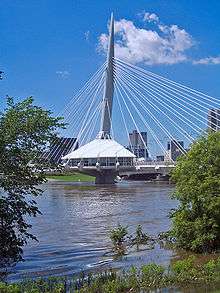
Winnipeg was named the Cultural Capital of Canada in 2010 by Canadian Heritage.[122] As of 2012, there are 26 National Historic Sites of Canada in Winnipeg.[123] One of these, The Forks, attracts four million visitors a year.[124] It is home to the City television studio, Manitoba Theatre for Young People, the Winnipeg International Children's Festival, and the Manitoba Children's Museum. It also features a 30,000-square-foot (2,800 m2) skate plaza, a 8,500-square-foot (790 m2) bowl complex, which features a mural of Winnipeg skateboarding pioneer Jai Pereira, the Esplanade Riel bridge,[125] a river walkway, Shaw Park, and the Canadian Museum for Human Rights.[124] The Winnipeg Public Library is a public library network with 20 branches throughout the city, including the main Millennium Library.[126]
Winnipeg the Bear, which would become the inspiration for part of the name of Winnie-the-Pooh, was purchased in Ontario by Lieutenant Harry Colebourn of the Fort Garry Horse. He named the bear after the regiment's home town of Winnipeg.[127] A. A. Milne later wrote a series of books featuring the fictional Winnie-the-Pooh. The series' illustrator, Ernest H. Shepard, created the only known oil painting of Winnipeg's adopted fictional bear, displayed in Assiniboine Park.[128]
The city has developed many distinct dishes and cooking styles, notably in the areas of confectionery and hot-smoked fish. Both the First Nations and more recent Eastern Canadian, European, and Asian immigrants have helped shape Winnipeg's dining scene, giving birth to dishes such as the desserts schmoo torte and wafer pie.[129][130]
The Winnipeg Art Gallery is Western Canada's oldest public art gallery, founded in 1912. It is the sixth-largest in the country[131] and includes the world's largest public collection of contemporary Inuit art.[12][132] Since the late 1970s Winnipeg has also had an active artist run centre culture.[133]
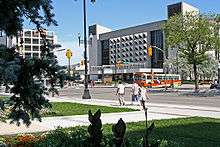
Winnipeg's three largest performing arts venues, the Centennial Concert Hall, Royal Manitoba Theatre Centre and the Pantages Playhouse Theatre, are downtown. The Royal Manitoba is Canada's oldest English-language regional theatre, with over 250 performances yearly.[134] The Pantages Playhouse Theatre opened as a vaudeville house in 1913.[135] Other city theatres include the Burton Cummings Theatre (a National Historic Site of Canada built in 1906[136]) and Prairie Theatre Exchange. Le Cercle Molière, based in St Boniface, is Canada's oldest theatre company; it was founded in 1925.[137] Rainbow Stage is a musical theatre production company based in Kildonan Park that produces professional, live Broadway musical shows and is Canada's longest-surviving outdoor theatre.[12][138] The Manitoba Theatre for Young People at The Forks is one of only two Theatres for Young Audiences in Canada with a permanent residence and the only Theatre for Young Audiences that offers a full season of plays for teenagers.[139] The Winnipeg Jewish Theatre is the only professional theatre in Canada dedicated to Jewish themes.[140] Shakespeare in the Ruins (SIR) presents adaptations of Shakespeare plays.[141]
Winnipeg has hosted a number of Hollywood productions: Shall We Dance? (2004), Capote (2005), The Assassination of Jesse James by the Coward Robert Ford (2007), and Goon (2011) among others had parts filmed in the city.[142] The Winnipeg Film Group has produced numerous award-winning films.[143] There are several TV and film production companies in Winnipeg: the most prominent are Farpoint Films, Frantic Films, Buffalo Gal Pictures, and Les Productions Rivard.[144] Guy Maddin's My Winnipeg, an independent film released in 2008, is a comedic rumination on the city's history.[145]
The Winnipeg Symphony Orchestra is the largest and oldest professional musical ensemble in Winnipeg.[146] The Manitoba Chamber Orchestra runs a series of chamber orchestral concerts each year.[147] Manitoba Opera is Manitoba's only full-time professional opera company.[148] Among the most notable musical acts associated with Winnipeg are Comeback Kid, Bachman–Turner Overdrive,[149] the Crash Test Dummies,[150] The Guess Who,[151] Neil Young,[152] The Wailin' Jennys, and The Weakerthans.[149]
The Royal Winnipeg Ballet (RWB) is Canada's oldest ballet company and the longest continuously operating ballet company in North America. It was the first organization to be granted a royal title by Queen Elizabeth II, and has included notable dancers such as Evelyn Hart and Mikhail Baryshnikov. The RWB also runs a full-time classical dance school.[153]
The Manitoba Museum, the city's largest museum, depicts the history of the city and province. The full-size replica of the ship Nonsuch is the museum's showcase piece.[154] The Manitoba Children's Museum is a nonprofit children's museum at The Forks that features twelve permanent galleries.[155][156] The Canadian Museum for Human Rights is the only Canadian national museum for human rights and the only national museum west of Ottawa.[157] The federal government contributed $100 million towards the estimated $311-million project.[158] Construction of the museum began on 1 April 2008,[159] and the museum opened to the public 27 September 2014.[160]
The Western Canada Aviation Museum, in a hangar at Winnipeg's James Richardson International Airport, features military jets, commercial aircraft, Canada's first helicopter, the "flying saucer" Avrocar, flight simulators, and a Black Brant rocket built in Manitoba by Bristol Aerospace.[161] The Winnipeg Railway Museum at Via Rail Station has a variety of locomotives, notably the Countess of Dufferin, the first steam locomotive in Western Canada.[162]
Festivals

Festival du Voyageur, Western Canada's largest winter festival, celebrates the early French explorers of the Red River Valley.[163] Folklorama is the largest and longest-running cultural celebration festival in the world.[164] The Jazz Winnipeg Festival and the Winnipeg Folk Festival both celebrate Winnipeg's music community. The Winnipeg Music Festival offers a competition venue to amateur musicians. The Winnipeg Fringe Theatre Festival is the second-largest alternative theatre festival in North America.[165] The Winnipeg International Writers Festival (also called THIN AIR) brings writers to Winnipeg for workshops and readings.[166] The LGBT community in the city is served by Pride Winnipeg, an annual gay pride festival and parade, and Reel Pride, a film festival of LGBT-themed films.[167]
Sports
Winnipeg has been home to several professional hockey teams. The Winnipeg Jets of the National Hockey League (NHL) have called the city home since 2011.[168] The original Winnipeg Jets, the city's former NHL team, left for Phoenix, Arizona after the 1995–96 season due to mounting financial troubles, despite a campaign effort to "Save the Jets".[169] The Jets play at Bell MTS Place, which is ranked the world's 19th-busiest arena among non-sporting touring events, 13th-busiest among facilities in North America, and 3rd-busiest in Canada as of 2009.[170]
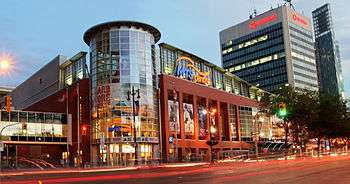
Past hockey teams based in Winnipeg include the Winnipeg Maroons, Winnipeg Warriors, three time Stanley Cup Champion Winnipeg Victorias and the Winnipeg Falcons, who were the first ever Gold Medal Olympians, representing Canada in 1920 in Antwerp, Belgium. Another professional ice hockey team in Winnipeg is the Manitoba Moose, the American Hockey League primary affiliate of the Winnipeg Jets that are owned by the same group .[171][172] In amateur hockey, the Winnipeg Blues of the Manitoba Junior Hockey League play out of the Bell MTS Iceplex.[173] On the international stage, Winnipeg has hosted national and world hockey championships on a number of occasions, most notably the 1999 World Junior Hockey Championship and 2007 Women's World Hockey Championship.[174][175] In 2019, the Western Hockey League returned to Winnipeg after a long absence with the Kootenay Ice relocating as the Winnipeg Ice.
The Winnipeg Blue Bombers play in the Canadian Football League. They are eleven-time Grey Cup champions, their last championship in 2019.[176] From 1953 to 2012, the Blue Bombers called Canad Inns Stadium home; they have since moved to IG Field. Due to construction delays and cost overruns, the stadium was not ready for the 2012 CFL season, instead opening in 2013. The $200-million facility is also the home to U Sports' University of Manitoba Bisons and the Winnipeg Rifles of the Canadian Junior Football League.[177][178]
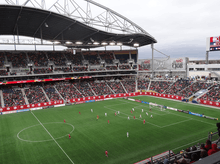
The University of Manitoba Bisons and the University of Winnipeg Wesmen represent the city in university-level sports.[179] In soccer, it is represented by both Valour FC in the new Canadian Premier League[180] and WSA Winnipeg in the USL League Two.[181]
Winnipeg has been home to several professional baseball teams, most recently the Winnipeg Goldeyes since 1994. The Goldeyes play at Shaw Park, which was completed in 1999. The team had led the Northern League for ten straight years in average attendance through 2010, with more than 300,000 annual fan visits, until the league collapsed and merged into the American Association of Independent Professional Baseball.[182]
Winnipeg was the first Canadian city to host the Pan American Games, and the second city to host the event twice, in 1967 and again in 1999.[183] The Pan Am Pool, built for the 1967 Pan Am Games, hosts aquatic events, including diving, speed swimming, synchronized swimming and water polo.[184] Winnipeg co-hosted the 2015 FIFA Women's World Cup.[185]
| Club | Sport | League | Venue | Established | Championships |
|---|---|---|---|---|---|
| Winnipeg Blue Bombers | Football | CFL | Osborne Stadium (1935–1952) Winnipeg Stadium (1953–2012) IG Field (2013–present) |
1930 | 11 |
| Winnipeg Jets | Ice hockey | WHA, NHL | Winnipeg Arena (1972–1996) Bell MTS Place (2011–present) |
Original: 1972–1996 Current: 2011 |
3 (WHA Avco Cup) 0 |
| Valour FC | Soccer | CPL | IG Field | 2018 | 0 |
| Winnipeg Goldeyes | Baseball | Northern League (1994–2010) American Association (2011–present) |
Shaw Park | 1994 | 4 |
| Manitoba Moose | Ice hockey | IHL (1996–2001) AHL (2001–2011, 2015–present) |
Winnipeg Arena (1996–2004) Bell MTS Place (2004–2011, 2015–present) |
1996–2011, 2015–present | 0 |
Local media
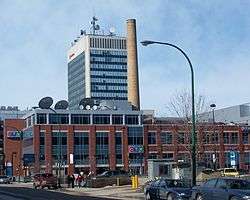
Winnipeg has two daily newspapers: the Winnipeg Free Press and the Winnipeg Sun.[186] There are five weekly newspapers delivered free to most Winnipeg households by region. There are also several ethnic weekly newspapers.[187] Local magazines include Border Crossings.
Radio broadcasting in Winnipeg began in 1922;[188] by 1923, government-owned CKY held a monopoly position that lasted until after the Second World War. Winnipeg is home to 33 AM and FM radio stations, two of which are French-language stations.[189] CBC Radio One and CBC Radio 2 broadcast local and national programming in the city.[190] NCI is devoted to Indigenous programming.[191]
Television broadcasting in Winnipeg started in 1954. The federal government refused to license any private broadcaster until the Canadian Broadcasting Corporation had created a national network. In May 1954, CBWT went on the air with four hours of broadcasting per day.[192] There are now five English-language stations and one French-language station based in Winnipeg. Additionally, some American network affiliates are available over-the-air.[193]
Law and government
Since 1992, the city of Winnipeg has been represented by 15 city councillors and a mayor, both elected every four years.[194] The present mayor, Brian Bowman, was elected to office in 2014.[12] The city is a single-tier municipality, governed by a mayor-council system.[12] The structure of the municipal government is set by the provincial legislature in the City of Winnipeg Charter Act, which replaced the old City of Winnipeg Act in 2003.[195] The mayor is elected by direct popular vote to serve as the chief executive of the city.[196] At Council meetings, the mayor has one of 16 votes. The City Council is a unicameral legislative body, representing geographical wards throughout the city.[195]
In provincial politics, Winnipeg is represented by 31 of the 57 provincial Members of the Legislative Assembly (MLAs). As of 2016, Winnipeg districts are represented by 17 members of the Progressive Conservative Party, 10 by the New Democratic Party (NDP), and 2 by the Liberal Party.[197]
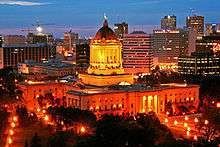
In federal politics, as of 2015 Winnipeg is represented by eight Members of Parliament: seven Liberals and one New Democrat.[198] There are six Senators representing Manitoba in Ottawa: three Liberals, two Conservatives, and one Independent.[199]
Crime
From 2007 to 2011, Winnipeg was the "murder capital" of Canada, with the highest per-capita rate of homicides; it fell to second place in 2012, behind Thunder Bay.[200][201] Winnipeg has had the highest violent crime index since 2009. The robbery rate in 2012 was between 250.1 and 272.9.[202][203] Despite high overall violent crime rates, crime in Winnipeg is mostly concentrated in the inner city, which makes up only 19% of the population[204] but was the site of 86.4% of the city's shootings, 66.5% of the robberies, 63.3% of the homicides and 59.5% of the sexual assaults in 2012.[202]
From the early 1990s to the mid-2000s, Winnipeg had a significant auto-theft problem, with the rate peaking at 2,165.0 per 100,000 residents in 2006[205] compared to 487 auto-thefts per 100,000 residents for Canada as a whole.[206] To combat auto theft, Manitoba Public Insurance established financial incentives for motor vehicle owners to install ignition immobilizers in their vehicles, and now requires owners of high-risk vehicles to install immobilizers.[207] The auto-theft rate has been on a constant drop since 2006. Other types of property crime have also decreased, but rates are still fairly high.[203][208]
As of 2018, the Winnipeg Police Service had 1,914 police officers, which is one officer per 551 city residents, and cost taxpayers $290,564,015.[209] In November 2013, the national police union reviewed the Winnipeg Police Force and found high average response times for several categories of calls.[210][211]
Education
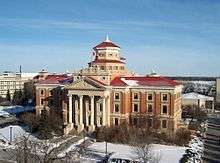
Winnipeg has seven school divisions: Winnipeg School Division, St. James-Assiniboia School Division, Pembina Trails School Division, Seven Oaks School Division, Division Scolaire Franco-Manitobaine, River East Transcona School Division, and Louis Riel School Division.[212] Winnipeg also has several religious and secular private schools.[213][214]
The University of Manitoba is the largest university in Manitoba.[215] It was founded in 1877, making it Western Canada's first university.[215] In a typical year, the university has 24,500 undergraduate students and 4,000 graduate students.[216] Université de Saint-Boniface is the city's only French-language university.[217] The University of Winnipeg received its charter in 1967.[218] Until 2007, it was an undergraduate institution that offered some joint graduate studies programs; it now offers independent graduate programs.[218] The Canadian Mennonite University is a private Mennonite undergraduate university established in 1999.[219]
Winnipeg also has two independent colleges: Red River College and Booth University College. Red River College offers diploma, certificate, and apprenticeship programs and, starting in 2009, began offering some degree programs.[220] Booth University College is a private Christian Salvation Army university college established in 1982. It offers mostly arts and seminary training.[221][222]
Infrastructure
Transportation
Winnipeg has had public transit since 1882, starting with horse-drawn streetcars.[223] They were replaced by electric trolley cars. The trolley cars ran from 1892 to 1955, supplemented by motor buses after 1918, and electric trolleybuses from 1938 to 1970.[223] Winnipeg Transit now runs diesel buses on its routes.[224]
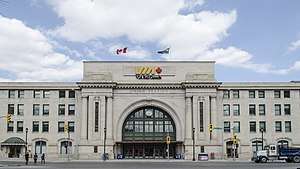
Winnipeg is a railway hub and is served by Via Rail at Union Station for passenger rail, and Canadian National Railway, Canadian Pacific Railway, Burlington Northern Santa Fe Manitoba, and the Central Manitoba Railway for freight rail. It is the only major city between Vancouver and Thunder Bay with direct US connections by rail.[225]
Winnipeg is the largest and best connected city within Manitoba, and has highways leading in all directions from the city. To the south, Winnipeg is connected to the United States via Provincial Trunk Highway 75 (PTH 75) (a continuation of I-29 and US 75, known as Pembina Highway or Route 42 within Winnipeg). The highway runs 107 km (66 mi) to Emerson, Manitoba, and is the busiest Canada–United States border crossing on the Prairies.[226] The four-lane Perimeter Highway, built in 1969, serves as a Ring Road, with at-grade intersections and a few interchanges. It allows travellers on the Trans-Canada Highway to bypass the city. A recent study cited dangerous intersections and low efficiency as its primary shortfalls.[227] The Trans-Canada Highway runs east to west through the city (city route), or circles around the city on the Perimeter Highway (beltway). Some of the city's major arterial roads include Route 80 (Waverley St.), Route 155 (McGillivray Blvd), Route 165 (Bishop Grandin Blvd.), Route 17 (Chief Peguis Trail), and Route 90 (Brookside Blvd., Oak Point Hwy., King Edward St., Century St., Kenaston Blvd.).[228]
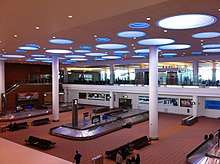
The Winnipeg James Armstrong Richardson International Airport completed a $585-million redevelopment in October 2011. The development brought a new terminal, a four-level parking facility, and other infrastructure improvements.[229] Winnipeg Bus Terminal, at Winnipeg International Airport, previously served by Greyhound Canada (through its subsidiary Grey Goose Bus Lines), Winnipeg Shuttle Service and Brandon Air Shuttle. Since Greyhound's exit from Western Canada, very few remaining routes still serve the terminal.[230] Approximately 20,000 acres (81 km2) of land to the north and west of the airport has been designated as an inland port, CentrePort Canada, and is Canada's first Foreign Trade Zone. It is a private sector initiative to develop the infrastructure for Manitoba's trucking, air, rail and sea industries.[231] In 2009, construction began on a $212-million four-lane freeway to connect CentrePort with the Perimeter Highway.[232] Named CentrePort Canada Way, it opened in November 2013.[233]
Several taxi companies serve Winnipeg, the largest being Unicity, Duffy's Taxi and Spring Taxi. Fifty percent of Winnipeg residents use a taxi at least once during the year.[234] Ride sharing was legalized in March 2018 and several services including TappCar and Cowboy Taxi operate in Winnipeg.[235] Cycling is popular in Winnipeg, and there are many bicycle trails and lanes around the city. Winnipeg holds an annual Bike-to-Work Day[236] and Cyclovia,[237] and bicycle commuters may be seen year-round, even in the winter. Active living infrastructure in Winnipeg encourages bicycling through the inclusion of bike lanes[238] and sharrows.[239]
Medical centres and hospitals
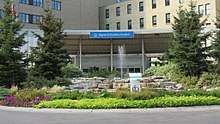
Winnipeg's major hospitals include Health Sciences Centre, Concordia Hospital, Deer Lodge Centre, Grace Hospital, Misericordia Health Centre, Riverview Health Centre, Saint Boniface General Hospital, Seven Oaks General Hospital, Victoria General Hospital, and The Children's Hospital of Winnipeg.[240]
The National Microbiology Laboratory in Winnipeg is one of only a handful of biosafety level 4 microbiology laboratories in the world.[241] The NML houses laboratories of the Public Health Agency of Canada (PHAC) and the Canadian Food Inspection Agency, in the National Centre for Foreign Animal Disease collocated in the same facility. Research facilities are also operated through hospitals and private biotechnology companies in the city.[242][243]
Utilities
Water and sewage services are provided by the city.[244] The city draws its water via an aqueduct from Shoal Lake, treating and fluoridating it at the Deacon Reservoir just outside the city prior to pumping it into the Winnipeg system.[245] The city's system has over 2,500 kilometres (1,600 mi) of underground water mains, which are subject to breakage during extreme weather conditions.[246]
Electricity and natural gas are provided by Manitoba Hydro, a provincial crown corporation headquartered in the city; it uses primarily hydroelectric power.[247] The primary telecommunications carrier is MTS,[248] although other corporations offer telephone, cellular, television and internet services.
Winnipeg contracts out several services to private companies, including garbage and recycling collection and street plowing and snow removal. This practice represents a significant budget expenditure and is more expansive than in comparable communities. The services have faced numerous complaints from residents in 2013–14 about missed service.[249][250][251]
Military

Canadian Forces Base Winnipeg, co-located at the airport, is home to many flight operations support divisions and several training schools. It is also the headquarters of 1 Canadian Air Division and the Canadian North American Aerospace Defense Command (NORAD) Region,[252] as well as the home base of 17 Wing of the Canadian Forces. The Wing comprises three squadrons and six schools; it also provides support to the Central Flying School.[253] Excluding the three levels of government, 17 Wing is the fourth largest employer in the city.[254] The Wing supports 113 units, stretching from Thunder Bay to the Saskatchewan–Alberta border, and from the 49th parallel to the high Arctic.[253] 17 Wing also acts as a deployed operating base for CF-18 Hornet fighter-bombers assigned to the Canadian NORAD Region.[253]
There are two squadrons based in the city. The 402 "City of Winnipeg" Squadron flies the Canadian-designed and produced de Havilland CT-142 Dash 8 navigation trainer.[255] The 435 "Chinthe" Transport and Rescue Squadron flies the Lockheed CC-130 Hercules in airlift search and rescue roles.[256] In addition, 435 Squadron is the only Royal Canadian Air Force squadron equipped and trained to conduct tactical air-to-air refueling of fighter aircraft.[256]
For many years, Winnipeg was the home of the Second Battalion of Princess Patricia's Canadian Light Infantry. Initially, the battalion was based at the Fort Osborne Barracks, now the location of the Rady Jewish Community Centre.[257] They eventually moved to the Kapyong Barracks between River Heights and Tuxedo. Since 2004, the battalion has operated out of CFB Shilo near Brandon.[258]
See also
References
- Municipal Manual. City of Winnipeg. 2007. p. 16.
- "Census subdivision of Winnipeg". Statistics Canada. Archived from the original on 3 March 2014. Retrieved 3 March 2014.
- "Census metropolitan area of Winnipeg". Statistics Canada. Archived from the original on 3 March 2014. Retrieved 3 March 2014.
- "Canadian Climate Normals 1981–2010 Station Data for Winnipeg". Environment Canada. Archived from the original on 5 September 2016. Retrieved 27 April 2016.
- "Census Profile, 2016 Census Winnipeg Census metropolitan area". Statistics Canada. Archived from the original on 11 February 2017. Retrieved 8 February 2017.
- "Census Profile, 2016 Census Winnipeg, City". Statistics Canada. Archived from the original on 11 February 2017. Retrieved 8 February 2017.
- "Population and dwelling counts, for Manitoba and census subdivisions". Statistics Canada. Archived from the original on 22 July 2012. Retrieved 6 April 2012.
- "Metropolitan areas of Manitoba". Statistics Canada. Archived from the original on 22 July 2012. Retrieved 8 February 2011.
- "Winnipeg". The World Clock. Archived from the original on 9 February 2014. Retrieved 3 March 2014.
- "History". The Forks. Archived from the original on 30 September 2008. Retrieved 4 November 2008.
- "Winnipeg River". Encyclopædia Britannica Online. 2009. Archived from the original on 1 April 2010.
- Artibise, Alan (11 September 2012). "Winnipeg". The Canadian Encyclopedia. Archived from the original on 24 February 2014.
- Harris, R. Cole; Matthews, Geoffrey J. (1993). Historical Atlas of Canada. 2. University of Toronto Press. pp. 1–6.
- Buckner, Anthony (Spring 1990). "Glacial Lake Agassiz". Manitoba History (19).
- Welsted, John, ed. (1996). The geography of Manitoba. University of Manitoba Press. p. 80. ISBN 978-0-88755-375-2.
- Lewis, G Malcolm (1998). Cartographic encounters: perspectives on Native American mapmaking and map use. University of Chicago Press. p. 12.
- "Pierre Gaultier de Varennes la Vérendrye". Dictionary of Canadian Biography. 3. pp. 246–254.
- Champagne, Antoine (1968–69). "The Vérendryes and Their Successors, 1727–1760". MHS Transactions. 3 (25).
- Parks Canada. "The Forks National Historic Site of Canada". Archived from the original on 5 June 2011. Retrieved 5 January 2007.
- Lussier, AS (Spring 1978). "The Metis: Contemporary Problem of Identity". Manitoba Pageant. 23 (3).
- "Thomas Douglas". Dictionary of Canadian Biography V. University of Toronto. 2000. pp. 264–269.
- Brown, Alice E (April 1962). "A Brief Chronology of Events Relative to Lord Selkirk's Settlement at Red River – 1811 to 1815". Manitoba Pageant. 7 (3).
- Bumstead, JM (1999). Fur Trade Wars: the founding of Western Canada. Great Plains Publications. ISBN 1-894283-03-1.
- "Battle at Seven Oaks". Canada: A People's History. CBC. Archived from the original on 19 June 2013. Retrieved 4 March 2014.
- "Manitoba Time Line". Manitoba Historical Society. Archived from the original on 26 May 2011. Retrieved 23 May 2011.
- "Greater Winnipeg: Upper Fort Garry Gate". Virtual Heritage Winnipeg. Archived from the original on 7 December 2008. Retrieved 16 July 2009.
- Hayes, Derek (2006). Historical Atlas of Canada. D&M Adult. pp. 213–214. ISBN 1-55365-077-8.
- Sprague, DN (1988). Canada and the Métis, 1869–1885. Wilfrid Laurier University Press. pp. 33–67, 89–129. ISBN 978-0-88920-964-0.
- Ross, David; Tyler, Grant (1992). Canadian campaigns 1860–70. Osprey. pp. 36–39. ISBN 978-1-85532-226-4.
- "Treaty 1". Winnipeg's Vital Signs. Archived from the original on 1 September 2018. Retrieved 31 August 2018.
- "History of Winnipeg: Historical Profile". City of Winnipeg. Archived from the original on 19 August 2011. Retrieved 8 December 2011.
- "Who Named the North-Land?". Manitoba Free Press. 19 August 1876. p. 3.
- "Winnipeg (Man.) – Winnipeg in Focus". winnipeginfocus.winnipeg.ca. Archived from the original on 4 March 2018. Retrieved 3 March 2018.
- "MHS Centennial Business: Canadian Pacific Railway Company". Manitoba Historical Society. Archived from the original on 29 August 2009. Retrieved 16 July 2009.
- "Controversy and compromise over the Manitoba Schools Question". Canada's History. Archived from the original on 27 May 2014. Retrieved 26 May 2014.
- Silicz, Michael (10 September 2008). "The heart of the continent?". The Manitoban. University of Manitoba.
- Hiller, Harry (2009). Second promised land: migration to Alberta and the transformation of Canadian society. McGill-Queen's University Press. pp. 33–34. ISBN 978-0-7735-3517-6.
- "The Winnipeg General Strike". Canada: A People's History. CBC. Archived from the original on 18 September 2014. Retrieved 4 March 2014.
- Bothwell, Robert; Drummond, Ian; English, John (1990). Canada, 1900–1945. University of Toronto Press. p. 165. ISBN 0-8020-6801-4.
- "Bloody Saturday". CBC. Archived from the original on 9 February 2014. Retrieved 7 April 2012.
- MacInnis, Grace (1953). J. S. Woodsworth: A Man to Remember. Macmillan.
- "The History". Legislative Tour. Province of Manitoba. Archived from the original on 13 April 2008. Retrieved 16 July 2009.
- Francis, RD; Ganzevoort, H, eds. (1980). The Dirty Thirties in Prairie Canada. Western Canadian Studies Conference. Tantalus Research. ISBN 0-919478-46-8.
- Vance, Jonathan (1994). Objects of concern: Canadian prisoners of war through the twentieth century. UBC Press. p. 183. ISBN 978-0-7748-0504-9.
- Burch, Ted (10 September 1960). "The day the Nazis took over Winnipeg". Maclean's: 46–47.
- Groom, Kick (5 January 1985). "If". Winnipeg Free Press. p. 1.
- Hurst, William D (1955–1956). "The Red River Flood of 1950". MHS Transactions Series 3. Manitoba Historical Society.
- Bumsted, JM (March 2002). "The Manitoba Royal Commission on Flood Cost Benefit and the Origins of Cost-Benefit Analysis in Canada". American Review of Canadian Studies. 32 (1): 97–121. doi:10.1080/02722010209481659.
- Lightbody, James (1978) [1971]. The Reform of a Metropolitan Government: The Case of Winnipeg. Canadian Public Policy.
- "Hansard". Manitoba Legislature. Archived from the original on 30 September 2007. Retrieved 8 August 2007.
- Sancton, Andrew; Young, Robert Andrew (2009). Foundations of governance: municipal government in Canada's provinces. University of Toronto Press. p. 250. ISBN 978-0-8020-9650-0.
- "Urban Development Agreements". Western Economic Diversification Canada. Archived from the original on 30 May 2009. Retrieved 16 July 2009.
- "Manitoba Flood Facts". Province of Manitoba. Archived from the original on 5 March 2014. Retrieved 4 March 2014.
- "Geomorphology of the Red River". Natural Resources Canada. Archived from the original on 4 June 2011. Retrieved 9 May 2012.
- "Manitoba's Tall Grass Prairie Preserve". Nature North Zine. Nature North. Archived from the original on 3 February 2014. Retrieved 27 February 2014.
- "Lake Winnipeg". World Lake Database. Archived from the original on 10 February 2007. Retrieved 4 March 2014.
- "Winnipeg Tree Facts" (PDF). City of Winnipeg. Archived from the original (PDF) on 5 March 2014. Retrieved 4 March 2014.
- Boulet, Charles. "Basement Flood Risk Reduction: City of Winnipeg" (PDF). Institute for Catastrophic Loss Reduction. Archived from the original (PDF) on 2 April 2015. Retrieved 4 March 2014.
- "Historical floods and flood disasters". Natural Resources Canada. Archived from the original on 19 July 2010. Retrieved 9 May 2012.
- "Red River Rising: Manitoba floods". CBC. Archived from the original on 31 December 2013. Retrieved 4 March 2014.
- "Floodway: part of war on mosquitoes?". Frontier Centre for Public Policy. 25 September 2002. Archived from the original on 2 April 2015.
- "Winnipeg, Manitoba Climate Summary". Weatherbase. Archived from the original on 11 February 2015. Retrieved 27 January 2015.
- "Updated world map of the Köppen-Geiger climate classification" (PDF). University of Melbourne. Archived (PDF) from the original on 3 February 2012. Retrieved 8 March 2011.
- "Most thunderstorm days". Environment Canada. Archived from the original on 20 January 2013. Retrieved 4 March 2014.
- "Canadian Climate Normals 1971–2000". Environment Canada. Archived from the original on 5 October 2013. Retrieved 7 March 2013.
- "Daily Data Report for February 2007". Environment Canada. Archived from the original on 3 February 2014. Retrieved 30 September 2012.
- "Canadian Climate Normals 1981–2010". Environment Canada. Archived from the original on 11 February 2015. Retrieved 11 February 2015.
- "Canadian Climate Normals 1971–2000". Environment Canada. Archived from the original on 3 February 2014. Retrieved 1 October 2012.
- "Sunniest City in Canada – Current Results". Archived from the original on 10 May 2015. Retrieved 19 May 2015.
- "Winnipeg, Manitoba Temperature Averages". Weatherbase. Archived from the original on 11 February 2015. Retrieved 27 January 2015.
- "Thunderstorms". Government of Manitoba. Archived from the original on 7 August 2016. Retrieved 14 May 2016.
- "July 1936". Environment Canada. Archived from the original on 9 June 2016. Retrieved 18 April 2016.
- "Winnipeg Richardson International A, Manitoba". Canadian Climate Normals 1981–2010. Environment Canada. Retrieved 7 May 2014.
- "Monthly Data Report for 1872". Canadian Historical Climate Data. Environment Canada. Retrieved 12 May 2016.
- "Daily Data Report for March 2012". Canadian Historical Climate Data. Environment Canada. Retrieved 12 May 2016.
- d.o.o, Yu Media Group. "Winnipeg, Canada – Detailed climate information and monthly weather forecast". Weather Atlas. Retrieved 5 July 2019.
- "Description of Geographies Used to Produce Census Profiles". City of Winnipeg. Archived from the original on 30 September 2012. Retrieved 14 October 2012.
- "Trends 2010" (PDF). Downtown Winnipeg BIZ. 8 July 2010. Archived from the original (PDF) on 11 January 2014.
- "Downtown Winnipeg Profile" (PDF). City of Winnipeg. Archived from the original (PDF) on 28 September 2011. Retrieved 5 March 2014.
- "Winnipeg, Manitoba" (PDF). International Network for Urban Research and Action. Archived from the original (PDF) on 4 May 2015. Retrieved 4 March 2014.
- "Assiniboine Park's Story". Assiniboine Park. Archived from the original on 16 February 2012. Retrieved 5 March 2014.
- "Shopping". Tourism Winnipeg. Archived from the original on 20 October 2013. Retrieved 4 March 2014.
- "Nightlife". Tourism Winnipeg. Archived from the original on 20 October 2013. Retrieved 4 March 2014.
- "Neighbourhoods: The Village Pilgrimage". Where.ca. Archived from the original on 7 August 2011. Retrieved 23 May 2011.
- "Osborne Village Neighbourhood Plan" (PDF). City of Winnipeg. June 2006. Archived (PDF) from the original on 20 January 2013.
- "Censuses 1871–1931" (PDF). Canada Year Book 1932. Statistics Canada. Archived (PDF) from the original on 19 October 2014. Retrieved 30 August 2014.
- "Census 1941–1951" (PDF). Canada Year Book 1955. Statistics Canada. Archived (PDF) from the original on 9 December 2013. Retrieved 30 August 2014.
- "Census 1961" (PDF). Canada Year Book 1967. Statistics Canada. Archived (PDF) from the original on 23 December 2014. Retrieved 30 August 2014.
- "Censuses 1966, 1971". Canada Year Book 1974. Statistics Canada.
- "Censuses 1981, 1986". Canada Year Book 1988. Statistics Canada.
- "Twenty-five largest municipalities" (PDF). The Daily. Statistics Canada. 28 April 1992. p. 9. Archived (PDF) from the original on 24 March 2014.
- "2001 Community Profiles: Winnipeg". Statistics Canada. Archived from the original on 9 December 2013. Retrieved 30 August 2014.
- "The Canadian Population in 2011" (PDF). Statistics Canada. p. 19. Archived (PDF) from the original on 2 July 2013. Retrieved 30 August 2014.
- "Winnipeg city population profile". Statistics Canada. Archived from the original on 11 February 2017. Retrieved 8 January 2013.
- "Winnipeg CMA population profile". Statistics Canada. Archived from the original on 11 February 2017. Retrieved 8 January 2013.
- "Population and dwelling counts, for Canada, provinces and territories". Statistics Canada. Archived from the original on 12 March 2014. Retrieved 5 March 2014.
- "Population and dwelling counts, for Canada and census subdivisions (municipalities)". Statistics Canada. Archived from the original on 25 June 2013. Retrieved 5 March 2014.
- "Census profile: Winnipeg (census metropolitan area)". Statistics Canada. Archived from the original on 5 March 2014. Retrieved 5 March 2014.
- "Annual population estimates by census metropolitan area, July 1, 2017". Statistics Canada. Retrieved 13 February 2018.
- "National Household Survey (NHS) Profile, 2011". Statistics Canada. Archived from the original on 3 December 2013. Retrieved 5 March 2014. Compared to similar profiles generated for other major cities.
- "Community Profile of the City of Winnipeg". Statistics Canada. 30 September 2007. Archived from the original on 8 January 2014. Retrieved 30 September 2007.
- "Census Profile: Winnipeg (city)". Statistics Canada. Archived from the original on 24 July 2013. Retrieved 5 March 2014.
- "Census Profile, 2016, Winnipeg". Statistics Canada. Archived from the original on 12 December 2018. Retrieved 10 June 2018.
- "Winnipeg Report" (PDF). Urban Aboriginal Peoples Study. Environics Institute. 2011. Archived (PDF) from the original on 7 December 2013.
- "National Household Survey – Reference products, 2011" (PDF). Statistics Canada. 28 May 2013. Archived (PDF) from the original on 1 February 2014. Retrieved 27 February 2014.
- "Community Trends Report" (PDF). City of Winnipeg. October 2013. Archived from the original (PDF) on 26 March 2014.
- "Economic performance indicators" (PDF). Economic Development Winnipeg Inc. Archived from the original (PDF) on 10 March 2016. Retrieved 4 July 2014.
- "Canadian cities: an economic snapshot" (PDF). CIBC. 3 January 2013. Archived (PDF) from the original on 23 January 2013. Retrieved 3 March 2014.
- "Winnipeg's quarterly economic highlights" (PDF). Economic Development Winnipeg. Archived from the original (PDF) on 23 September 2015. Retrieved 3 March 2014.
- "Manitoba unemployment rate bucks national trend". CTV. 10 January 2014. Archived from the original on 14 July 2014.
- "Labour force characteristics, unadjusted, by census metropolitan area (3-month moving average)". Statistics Canada. Archived from the original on 5 March 2014. Retrieved 3 March 2014.
- "Canada's largest employers by city". From Conference Board of Canada: Metropolitan Outlook: Economic Insights Into 27 Canadian Metropolitan Economies. University of Western Ontario. Archived from the original on 21 January 2010. Retrieved 17 July 2009.
- "Canadian Real Estate". Canadian Real Estate Magazine. December 2008.
- "Economic Base". City of Winnipeg Community Profile. Government of Manitoba. Archived from the original on 16 December 2007. Retrieved 17 July 2009.
- "Visit the Mint". Royal Canadian Mint. Archived from the original on 20 June 2009. Retrieved 17 July 2009.
- "Our Services". Royal Canadian Mint. Archived from the original on 20 June 2009. Retrieved 17 July 2009.
- "Winnipeg the most cost competitive in western Canada". KPMG. 22 March 2012. Archived from the original on 6 October 2012.
- "Consumer price index, by city (monthly)". Statistics Canada. Archived from the original on 28 February 2014. Retrieved 3 March 2014.
- "Median price". Canadian Real Estate Association. Archived from the original on 9 March 2014. Retrieved 3 March 2014.
- "Consumer Price Index, by city (monthly)". Statistics Canada. Archived from the original on 28 February 2014. Retrieved 4 July 2014.
- "Consumer Price Index, by province (monthly)". Statistics Canada. Archived from the original on 7 July 2014. Retrieved 5 July 2014.
- "Arts for All". Artsforall.ca. Archived from the original on 16 May 2014. Retrieved 27 February 2014.
- "Winnipeg". Directory of Federal Heritage Designations. Parks Canada. Retrieved 17 June 2012. See also: St. Boniface.
- "The Forks". The Forks. Archived from the original on 4 July 2010. Retrieved 4 July 2010.
- "Attractions". The Forks. Archived from the original on 3 July 2009. Retrieved 17 July 2009.
- "Library Services". Newcomers Pocket Guide to Winnipeg. City of Winnipeg. Archived from the original on 13 July 2009. Retrieved 17 July 2009.
- "History of Winnie the Pooh". Disney. Archived from the original on 28 July 2009. Retrieved 17 July 2009.
- "Ernest H. Shepard, Illustrator". Pooh Corner. Archived from the original on 28 August 2008. Retrieved 17 July 2009.
- "The road to our signature dish". Winnipeg Free Press. 3 July 2011. Archived from the original on 10 June 2014. – via HighBeam Research (subscription required)
- "Wafer? Flapper? Open Wide and Say 'Sals'". Winnipeg Free Press. 7 November 2012. Archived from the original on 10 June 2014. – via HighBeam Research (subscription required)
- "The Winnipeg Art Gallery". The Winnipeg Art Gallery. Archived from the original on 19 May 2012. Retrieved 9 May 2012.
- "Collection of The Winnipeg Art Gallery". The Winnipeg Art Gallery. Archived from the original on 21 April 2012. Retrieved 9 May 2012.
- "Artist run centre members". MARCC. Archived from the original on 18 November 2017. Retrieved 17 November 2017.
- "About MTC". Manitoba Theatre Centre. 2010. Archived from the original on 28 June 2008. Retrieved 14 July 2010.
- "Historic Places". HistoricPlaces.ca. Archived from the original on 21 May 2011. Retrieved 19 November 2011.
- "Walker Theatre National Historic Site of Canada". HistoricPlaces.ca. Archived from the original on 9 March 2014. Retrieved 5 March 2014.
- "La Compagnie" (in French). Cercle Molière. 2008. Archived from the original on 5 March 2014. Retrieved 5 March 2014.
- "About Rainbow Stage". Rainbow Stage. 1993. Archived from the original on 22 August 2008. Retrieved 17 July 2009.
- "MTYP". Manitoba Theatre for Young People. Archived from the original on 18 February 2009. Retrieved 17 July 2009.
- "About Us". Winnipeg Jewish Theatre. Archived from the original on 25 March 2010. Retrieved 17 July 2009.
- "About". Shakespeare in the Ruins. Archived from the original on 5 March 2014. Retrieved 5 March 2014.
- "Five flicks filmed in Winnipeg". Metro. 31 August 2012. Archived from the original on 9 March 2014.
- "Why make movies in Winnipeg?". CBC. Archived from the original on 16 March 2014. Retrieved 5 March 2014.
- "Awards & Nominations". Get on Set Manitoba. Archived from the original on 9 March 2014. Retrieved 5 March 2014.
- Gillmor, Alison (7 September 2007). "Home truths". CBC. Archived from the original on 18 March 2009.
- "More About the Wso". WSO. Archived from the original on 4 May 2008. Retrieved 17 July 2009.
- "Manitoba Chamber Orchestra". Encyclopedia of Music in Canada. Archived from the original on 9 March 2014. Retrieved 5 March 2014.
- "Did You Know?". About Manitoba Opera. Manitoba Opera. Archived from the original on 26 June 2009. Retrieved 17 July 2009.
- "2014 JUNO Awards". CARAS. Archived from the original on 4 March 2014. Retrieved 5 March 2014.
- Bateman, Jeff (15 December 2013). "Crash Test Dummies". The Canadian Encyclopedia. Archived from the original on 23 May 2014.
- "The Guess Who". Manitoba Music Museum. Archived from the original on 25 January 2012. Retrieved 21 May 2014.
- Kives, Bartley (17 January 2014). "Neil Young a typical Winnipegger". Winnipeg Free Press. Archived from the original on 9 March 2014.
- "History". Royal Winnipeg Ballet. Archived from the original on 29 July 2010. Retrieved 28 December 2009.
- "Museum Info". Manitoba Museum. Archived from the original on 7 March 2012. Retrieved 7 April 2012.
- "About the Children's Museum". Manitoba Children's Museum. Archived from the original on 26 August 2012. Retrieved 6 October 2012.
- "Children's Museum Now Open to the Public" (PDF). Manitoba Children's Museum. 6 June 2011. Archived from the original (PDF) on 1 December 2011. Retrieved 5 March 2014.
- "Construction FAQ". Canadian Museum for Human Rights. 2010. Archived from the original on 28 June 2010. Retrieved 4 July 2010.
- "Friends of Canadian Museum For Human Rights". The Friends of Canadian Museum For Human Rights. Archived from the original on 9 February 2010. Retrieved 4 July 2010.
- McNeill, Murray (9 February 2009). "Rights museum build begins April 1". Winnipeg Free Press. Archived from the original on 13 April 2009.
- Canadian Museum for Human Rights. ""Canada's new national museum opens, devoted entirely to human rights", press release,". Archived from the original on 10 November 2014. Retrieved 12 October 2014.
- McCaffery, Dan (2000). Canada's Warplanes: Unique Aircraft in Canada's Aviation Museums. James Lorimer & Company. p. 3. ISBN 978-1-55028-699-1.
- "The Winnipeg Railway Museum locomotives". The Winnipeg Railway Museum. Archived from the original on 3 June 2009. Retrieved 17 July 2009.
- "Historique" (in French). Festival du Voyageur. Archived from the original on 5 March 2014. Retrieved 5 March 2014.
- "FAQs". Folklorama. Archived from the original on 11 August 2010. Retrieved 17 July 2009.
- "Winnipeg Fringe Festival breaks attendance record". CBC. 28 July 2008. Archived from the original on 29 July 2008.
- "THIN AIR". ACI Manitoba. Archived from the original on 9 March 2014. Retrieved 5 March 2014.
- "The secret lives of volunteers". Outwords. April 2011. Archived from the original on 9 March 2014.
- Buma, Michael (2012). Refereeing identity: the cultural work of Canadian hockey novels. McGill-Queen's University Press. pp. 284–285. ISBN 978-0-7735-3987-7.
- "Hockey Flight in Canada". CBC. Archived from the original on 2 June 2008. Retrieved 17 July 2009.
- Maclean, Cameron (24 January 2009). "MTS Centre 19th-busiest showbiz venue in the world". Winnipeg Free Press. Archived from the original on 21 October 2013.
- Welsted, John, ed. (1996). The geography of Manitoba: its land and its people. University of Manitoba Press. p. 307. ISBN 978-0-88755-375-2.
- Romaniuk, Ross (18 October 2011). "Work finally getting underway on old arena site". Winnipeg Sun. Archived from the original on 18 May 2015.
- "About MTS Iceplex". MTS. 24 September 2010. Archived from the original on 10 March 2016.
- "1999 IIHF World Junior Championship". Hockey Canada. Archived from the original on 5 March 2014. Retrieved 5 March 2014.
- "2007 IIHF Women's World Championship". Hockey Canada. Archived from the original on 5 March 2014. Retrieved 5 March 2014.
- "Grey Cups". Winnipeg Blue Bombers. Archived from the original on 20 March 2014. Retrieved 5 March 2014.
- Penton, Kirk (28 June 2013). "Bombers greats called out for opening ceremonies at Investors Group Field". Winnipeg Sun. Archived from the original on 12 November 2013.
- Jahns, Kyle (23 August 2013). "Marsch finds comfort zone with Rifles". Winnipeg Free Press. Archived from the original on 5 March 2014.
- Prest, Ashley (2 February 2012). "Bisons, Wesmen get their mojo back". Winnipeg Free Press. Archived from the original on 5 March 2014.
- "Winnipeg soccer executive hopes new club will score with local youth". Globalnews.ca. Archived from the original on 10 June 2018. Retrieved 2 June 2018.
- Prest, Ashley (26 May 2011). "New soccer squad in town". Winnipeg Free Press. Archived from the original on 5 March 2014.
- "Winnipeg Goldeyes History". Winnipeg Goldeyes. Archived from the original on 11 July 2011. Retrieved 15 July 2010.
- Redmond, Gerald (6 January 2013). "Pan American Games". Canadian Encyclopedia. Archived from the original on 11 March 2016.
- City of Winnipeg. "Pan Am Pool". Archived from the original on 30 July 2010. Retrieved 21 July 2010.
- Tait, Ed (5 May 2012). "Winnipeg to host FIFA Women's World Cup". Winnipeg Free Press. Archived from the original on 8 December 2012.
- "Free Press rules latest readership survey". Winnipeg Free Press. 23 October 2013. Archived from the original on 5 March 2014.
- "Canadian Ethnic Newspapers Currently Received". Collections Canada. Archived from the original on 7 January 2008. Retrieved 5 March 2014.
- Garry Moir, On the Air: the golden age of Manitoba radio, Great Plains Publications, 2015, ISBN 978-1-927855-26-3, pp. 16-17
- "Winnipeg Radio Stations". tunein. Archived from the original on 27 March 2014. Retrieved 5 March 2014.
- "Manitoba". CBC. Archived from the original on 14 January 2014. Retrieved 5 March 2014.
- "About us". NCI. Archived from the original on 5 March 2014. Retrieved 5 March 2014.
- Shilliday, Greg, ed. (1995). Manitoba 125 – A History. 3. Great Plains Publications. ISBN 0-9697804-1-9.
- Bowman, John (12 June 2009). "Canadian over-the-air TV following U.S. down digital path". CBC. Archived from the original on 29 January 2013.
- "City Government". City of Winnipeg. Archived from the original on 25 December 2008. Retrieved 17 July 2009.
- The City of Winnipeg Charter Act Archived 16 April 2009 at the Wayback Machine. S.M. 2002, c. 39. Bill 39, 3rd Session, 37th Legislature. Manitoba Laws.
- "Election Services". City of Winnipeg. Archived from the original on 6 January 2010. Retrieved 17 July 2009.
- "Alphabetical list by constituency". Legislative Assembly of Manitoba. Archived from the original on 4 June 2016. Retrieved 13 June 2016.
- "Current constituencies". Canadian Parliament. Archived from the original on 5 March 2014. Retrieved 5 March 2014.
- "Senators by province". Canadian Parliament. Archived from the original on 4 May 2011. Retrieved 17 July 2009.
- "Manitoba murder capital of Canada for fifth year in a row". CTV. 24 July 2012. Archived from the original on 28 July 2014.
- "Manitoba's homicide rate highest among provinces". Winnipeg Free Press. 19 December 2013. Archived from the original on 5 March 2014.
- "CrimStat". City of Winnipeg. Archived from the original on 7 April 2013. Retrieved 28 November 2013.
- "Crimes in Canada, by type of violation, and by province and territory". Statistics Canada. Archived from the original on 21 November 2013. Retrieved 28 November 2013.
- "Inner City" (PDF). City of Winnipeg. Archived (PDF) from the original on 4 March 2016. Retrieved 27 February 2014.
- "Every Annual Crime Report". Winnipeg Police Service. Archived from the original on 1 November 2013. Retrieved 28 November 2013.
- "Crimes Rates in Canada 2006" (PDF). Statistics Canada. 28 November 2013. Archived (PDF) from the original on 23 June 2013.
- "Immobilizers to be mandatory on high-risk used cars in Manitoba". CBC. 23 August 2006. Archived from the original on 25 February 2008.
- "2012 Annual Crime Report" (PDF). Winnipeg Police Service. Archived (PDF) from the original on 1 November 2013. Retrieved 28 November 2013.
- "2018 Annual Statistical Report" (PDF). Winnipeg Police Service. Retrieved 16 June 2020.
- Santin, Aldo (8 November 2013). "Police help on way ... in 77 minutes". Winnipeg Free Press. Archived from the original on 11 November 2013.
- "Winnipeg police slow on domestic violence calls, report says". CBC. 8 November 2013. Archived from the original on 10 November 2013.
- "Manitoba School Divisions and Districts". Government of Manitoba. Archived from the original on 13 April 2018. Retrieved 28 April 2018.
- "Funded Independent Schools". Government of Manitoba. Archived from the original on 31 March 2016. Retrieved 10 March 2016.
- "Non-Funded Independent Schools". Government of Manitoba. Archived from the original on 27 August 2011. Retrieved 28 April 2018.
- "Quick Facts". University of Manitoba. Archived from the original on 5 June 2009. Retrieved 17 July 2009.
- "By the numbers". University of Manitoba. Archived from the original on 9 April 2014. Retrieved 28 April 2018.
- "Université de Saint-Boniface". Université de Saint-Boniface. Archived from the original on 3 January 2014. Retrieved 27 February 2014.
- "The History of the University of Winnipeg". University of Winnipeg. 21 February 2006. Archived from the original on 1 September 2009. Retrieved 17 July 2009.
- "About CMU". Canadian Mennonite University. Archived from the original on 28 April 2018. Retrieved 28 April 2018.
- "Academic Annual Report" (PDF). Red River College. Archived from the original (PDF) on 5 March 2014. Retrieved 5 March 2014.
- "Our Story". Booth University College. Archived from the original on 28 April 2018. Retrieved 28 April 2018.
- "Academics". Booth University College. Archived from the original on 22 November 2018. Retrieved 28 April 2018.
- Bradley, Walter (1958–1959). "A History of Transportation in Winnipeg". MHS Transactions Series 3. Manitoba Historical Society.
- "Interesting Transit Facts". City of Winnipeg. Archived from the original on 10 March 2015. Retrieved 17 July 2009.
- "Rail transportation" (PDF). Destination Winnipeg. Archived from the original (PDF) on 27 August 2010. Retrieved 5 March 2014.
- NAIPN. "North American Inland Ports". Archived from the original on 21 November 2006. Retrieved 24 February 2007.
- FCPP. "Winnipeg's perimeter highway: "Disaster by design"" (PDF). Archived from the original on 10 March 2016. Retrieved 8 November 2008.
- "Winnipeg Transportation Master Plan" (PDF). City of Winnipeg. 2 November 2011. Archived from the original (PDF) on 20 January 2012.
- Halstead, Jason (28 October 2011). "Winnipeg's James A. Richardson International Airport ready for takeoff". Winnipeg Sun. Archived from the original on 21 November 2015.
- "Greyhound Canada plans move into new Winnipeg facility". Daily Commercial News. 9 June 2008. Archived from the original on 8 July 2011.
- "CentrePort Canada". CentrePort Canada Inc. Archived from the original on 28 June 2010. Retrieved 4 July 2010.
- Cash, Martin (8 May 2009). "Inland port's potential touted". Winnipeg Free Press. Archived from the original on 15 December 2009.
- "PM Harper officially opens CentrePort Canada Way highway". Winnipeg Free Press. Archived from the original on 5 November 2014. Retrieved 29 August 2014.
- "Winnipeg Taxi Study (Volume One – Report)" (PDF). Winnipeg Taxi Study. Tennessee Transportation & Logistics Foundation. 4 February 2009. p. 59. Archived from the original (PDF) on 20 January 2013. Retrieved 16 August 2012.
- "Two rides and a missing cowboy: CBC tries out new ride-hailing apps". CBC. 2 March 2018. Archived from the original on 24 July 2018.
- Batchelor, Megan (22 June 2012). "Bike to Work Day hits Winnipeg streets". Global Winnipeg. Archived from the original on 20 January 2013.
- Kives, Bartley (21 August 2009). "Cyclovia coming to downtown". Winnipeg Free Press. Archived from the original on 3 March 2012.
- "Bike Lanes". City of Winnipeg. Archived from the original on 20 January 2013. Retrieved 30 July 2012.
- "Sharrows Usage Guidelines". City of Winnipeg. Archived from the original on 20 January 2013. Retrieved 30 July 2012.
- "WRHA Hospitals & Facilities". Winnipeg Regional Health Authority. Archived from the original on 3 May 2009. Retrieved 17 July 2009.
- "NML Overview". Public Health Agency of Canada. Archived from the original on 12 June 2009. Retrieved 17 July 2009.
- "Winnipeg Life Sciences" (PDF). Economic Development Winnipeg. Archived from the original (PDF) on 3 December 2012. Retrieved 5 March 2014.
- "Working together". Manitoba Health Research Council. Archived from the original on 29 June 2014. Retrieved 5 March 2014.
- "Water and Waste Department". City of Winnipeg. Archived from the original on 28 February 2014. Retrieved 3 March 2014.
- "Water treatment program". City of Winnipeg. Archived from the original on 3 March 2014. Retrieved 3 March 2014.
- "Water main breaks". City of Winnipeg. Archived from the original on 3 March 2014. Retrieved 3 March 2014.
- "About Us". Manitoba Hydro. Archived from the original on 3 March 2014. Retrieved 3 March 2014.
- "Corporate profile". BellMTS. Archived from the original on 12 October 2013. Retrieved 3 March 2014.
- "Winnipeg's trash contractor facing $400k in fines". CBC. 7 January 2013. Archived from the original on 24 September 2015.
- "Officials defend Winnipeg's scorned snow clearing efforts". CBC. 7 January 2014. Archived from the original on 27 February 2014.
- Santin, Aldo (5 October 2013). "Snow-clearing cut proposed". Winnipeg Free Press. Archived from the original on 10 February 2014.
- "NORAD". Department of Defence. 23 March 2000. Archived from the original on 9 June 2011. Retrieved 5 March 2014.
- "17 Wing Consolidation Project at CFB Winnipeg". Department of Defence. 11 July 2003. Archived from the original on 9 June 2011.
- "Community". National Defence. Archived from the original on 11 June 2011. Retrieved 5 March 2014.
- "History". National Defence. Archived from the original on 15 March 2012. Retrieved 5 March 2014.
- "General Information". National Defence. Archived from the original on 6 December 2010. Retrieved 5 March 2014.
- "Explore Our Heritage – Provincial Heritage Sites". Government of Manitoba. Archived from the original on 22 February 2014. Retrieved 5 March 2014.
- "Winnipeg mayor wants negotiations in Kapyong Barracks dispute". CBC. 29 January 2014. Archived from the original on 9 March 2014.
Notes
- Climate data was recorded at St. John's College from March 1872 to July 1938, and at Winnipeg Airport from January 1938 to present.
Further reading
- Artibise, Alan F. J. (1979). Gateway City: Documents on the City of Winnipeg 1873-1913 (PDF). Manitoba Record Society Publications.
- Hamilton, John David (1998). A Winnipeg album: glimpses of the way we were. Hounslow Press. ISBN 0-88882-204-9.
- Friesen, Gerald (2009). Prairie metropolis: new essays on Winnipeg social history. University of Manitoba Press. ISBN 0-88755-713-9.
External links
- Official website



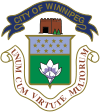
.svg.png)

